
Recent Works for the Army Staff Artist Program
The U.S. Army Center of Military History, Museum Division, frequently uses soldier-artists to document field operations. Colonel Gary N. “Butch” Cassidy (Ret.) produced the following works of art. Col. Cassidy was recalled from retirement to active duty on 1 December 1997 for six months. He deployed for the second time to Bosnia in February 1998. These paintings and drawings were exhibited at the Old Guard Museum, Fort Myer, Virginia, 7 July - 30 September 1998, at National Defense University, Fort McNair, Washington, D.C., from 30 September -18 December, 1998 and at the Army War College, Carlisle, Pennsylvania, from 11 January - 5 May 1999.
Colonel Gary N. Cassidy
Colonel Gary N. Cassidy - U.S. Army (Ret.) served in Vietnam, the Persian Gulf, and the peacekeeping efforts in Bosnia. He holds a Bachelor of Fine Arts from Washington University, Missouri, and a Master of Fine Arts from Claremont Graduate University, California. Col. Cassidy spent most of his military service in Special Operations with over twenty years as a Psychological Operations (PSYOP) specialist.
Col. Cassidy’s most recent mission to Bosnia was to collect images to produce a series of paintings and drawings documenting the Army’s experience in Bosnia.
THE BOSNIA ART PROJECT
Col. Cassidy asked our troops what they would remember the most about their tour of duty in Bosnia. Many said, “All the minefields.” Others replied “Guard duty and all the mud”. Many spoke of being impressed with the old structures and cities. The artist has captured the soldier’s memories in these works of art.
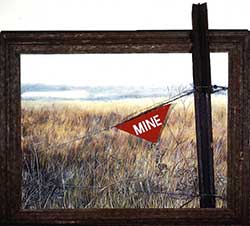
Minefield
Barbed Wire Engineer Stake and Mine Sign
44"x48" Oil on Canvas
Print version
"In coming up with subject matter to best artistically record images that I saw in Bosnia, I looked for common everyday things. Things that the troops would remember twenty years from now. One of the things I saw that I know will impress me the rest of my life, was the presence of minefields—many minefields." Col. Gary N. "Butch" Cassidy.
This assemblage; painting, engineer stake, barbed wire, and Mine sign can in no way show the vast amount of denied area that exists in Bosnia. The fields once plowed by farmers have turned to weeds and a killing ground.
Col. Cassidy said, " The advice the troops pass along is as simple as it is wise: Stay on the hardtop and if you didn’t drop it, don’t pick it up."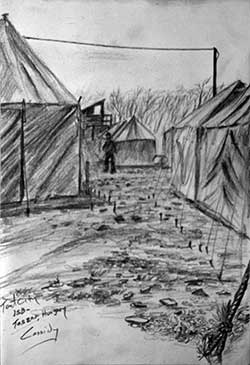
Tent City
8"x11" Pencil on Paper
Print version
A staging base in Taszar, Hungry, used to complete preparations before entering Bosnia, and the last stop before leaving Bosnia —lots of troops, lots of tens, not much to do.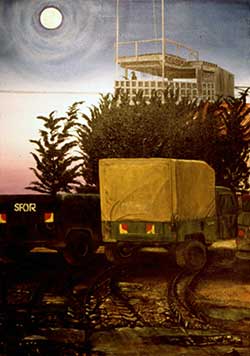
Sentry at "Mud" Govern
30"x40" Acrylic on Canvas
Print version
Sentry at "Mud" McGovern is dedicated to all the troops that have pulled duty in a lonely place far from home. Camp McGovern, located on a gently rolling plane outside of the town of Brcko, is surrounded by minefields. There is only one safe route in and out.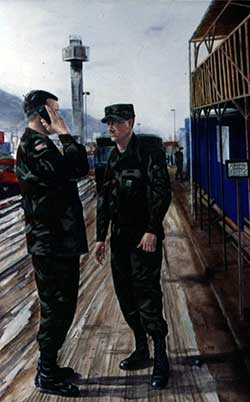
Logistics at Butmir
Acrylic on Canvas
24 x 36
Print version
The Command Sergeant Major at Butmir, outside of Sarajevo, relays by cell phone to the logistics major what supplies are needed by the troops. Butmir is a staging base where supplies and equipment are received, sorted, assembled, and repacked for distribution by the multi-national force to the troops.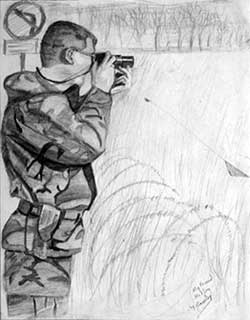
Photographing Minefields
Pencil on Paper
8 x 11
Print version
This drawing of LTC Ed Magdizak, an accomplished photographer, proved to be an invaluable resource to Col. Cassidy during his first visit to Bosnia. The ever-present minefield warnings were a constant reminder of how dangerous a peacekeeping mission can be.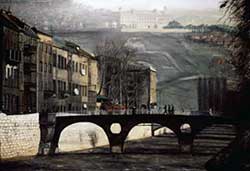
Peacekeepers on the Princip Bridge
Oil on Canvas
24 x 36
Print version
The assassination of Archduke Ferdinand on 28 June 1914 on this bridge, set off a series of events leading to lead to World War I. The bridge is located in Sarajevo over the Miljacka River. U.S. Army Peacekeepers crossed this bridge everyday.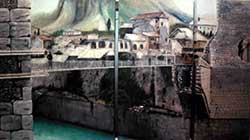
The New Bridge at Mostar
Acrylic on Canvas, a Triptych
26" x 53"
Print version
The original bridge at Mostar, Bosnia, built in the fifteenth century was destroyed during the four year Bosnian war. The bridge built over the Neretva River became a casualty of the war.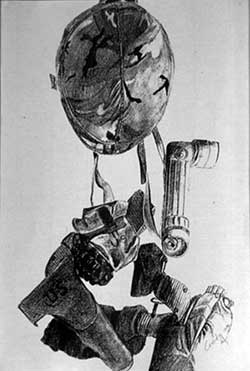
1970's GEAR
Pencil on Paper
11 x 17
Print version
Col. Cassidy did the first drawing for an art class in 1979. For the Bosnia Art Project he hung up his Load Bearing Equipment (LBE), helmet, and 9mm pistol and created a drawing similar to the one nineteen years earlier, but with 1990s LBE.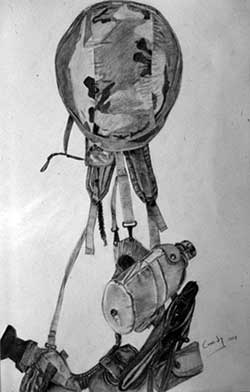
1990's GEAR
Pencil on Paper
11 x 17
Print version
